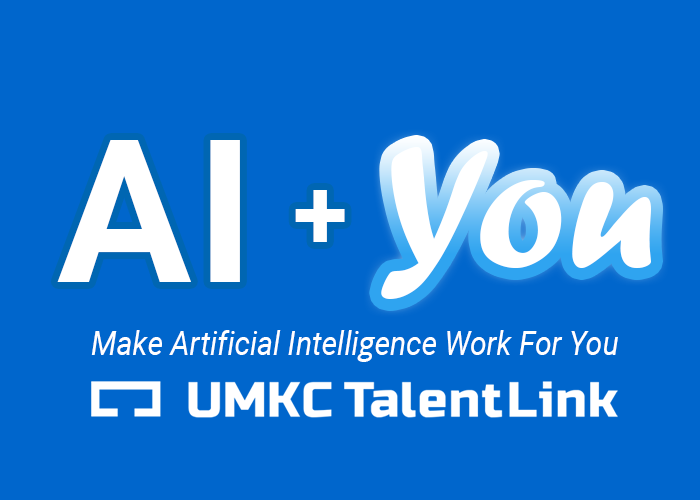homepage | Four Takeaways From AI Tools for Entrepreneurs Workshop Presenter Doug Hohulin
June 6, 2023
June 6, 2023

Next CoLabs Chief Innovation Officer Doug Hohulin recently presented at the Artificial Intelligence Tools for Entrepreneurs Workshop organized by KC Digital Drive. The UMKC TalentLink team gained numerous insights from Hohulin, a Generative AI consultant, and others about AI’s implications for industries, businesses, and workers.
Here are four takeaways from Hohulin’s presentation and other resources shared from the workshop.
Microsoft’s 2023 Annual Work Trend Index surveyed 31,000 people in 31 countries. The survey “analyzed trillions of aggregated productivity signals in Microsoft 365, along with labor market trends on LinkedIn to understand what the new era of AI means for work,” explained Hohulin.
Survey results show that “the pace and volume of work has increased exponentially.” Employees are buried by work and devote less energy and resources to innovation. “Leaders and employees alike are eager for AI to lift the burden,” noted Hohulin.
Nearly 2 in 3 leaders indicate that “a lack of innovation or breakthrough ideas on their teams is a concern.”
AI can free time and energy from mundane tasks, allowing more focus time for creative work and strategic thinking that leads to innovation. For example, common productivity disruptors include too many meetings, inefficient meetings, and the inability to access needed information.
Tip: AI-powered intelligent meeting recaps, transcripts, and recordings can transform a meeting into a “digital artifact” instead of a static point in time. People can access a digitally recorded meeting with AI when they need to find key information with ease and speed. Here are 10 tools to explore.
OpenAI launched its AI-powered conversational robot ChatGPT on November 30, 2022. The chatbot’s number of active users jumped from 100 million in January 2023 to a projected 173 million by April. ChatGPT became the fastest-ever platform to reach the 100 million user mark.
Host website openai.com logged an estimated 1.8 billion unique visitors per month in April 2023, according to SimilarWeb. Yet there remains ample room for growth and user adoption. By comparison, Amazon’s site has 2.2 billion monthly visitors, Instagram attracts 6.3 billion users, and Google leads with 83.9 billion users per month.
Have you tried using ChatGPT or alternatives such as Microsoft Bing, Google Bard AI, and Jasper Chat?
Tip: Here’s how to use ChatGPT to build your resume, write Excel formulas, summarize content, translate language with context, or assist with market research.
Learn more about Artificial Intelligence.
ChatGPT mimics human dialogue and decision-making, asserts Accenture. Those attributes increase user’s interest and public adoption.
Chatbots like ChatGPT enable AI to finally handle language complexity. Now, a machine “can learn language, context, and intent and be independently generative and creative.” These models can be “adapted or fine-tuned for a wide range of tasks.”
Currently, we’re in the early-adopter phase of the technology. Individuals and businesses are setting up accounts and trying out AI tools. Novel uses and initial practice leads to more practical applications, experimentation, and, ultimately, innovation.
AI as Helper – AI tools will automate and perform some work. In other cases, AI will serve as a “co-pilot” to augment work, transform how workers achieve tasks, and improve productivity.
What’s next? Accenture contends that most companies will need to customize how they use off-the-shelf AI tools and apps. Entrepreneurs will develop customizable AI tools and apps. Businesses will learn how to fine-tune those AI tools with proprietary data. They’ll develop ways to enhance employee capabilities, engage customers, explore fresh business models, and more.
Researchers contend that 80 percent of the US workforce could have at least 10 percent of their tasks affected by the introduction of large language models (LLMs) that support AI tools like OpenAI’s ChatGPT. Researchers found that around 19 percent of workers will see at least 50 percent of their tasks impacted.
What jobs are most likely to be impacted?
Roles heavily reliant on science and critical thinking skills will be less impacted. Trades and physical task-oriented work are also less likely to be impacted. These roles include equipment operators, carpenters, roofers, mechanics, masons, hospitality workers, miners, and meatpackers.
Knowledge-based fields such as programming, journalism, legal secretaries, accountants, and web designers are more susceptible to work being performed by AI tools. Industries that will be most impacted include data processing, information services, publishing, and insurance.
These forecasts are neither comprehensive nor absolute. Like the use of the internet and online search, advanced AI tools and apps are bound to evolve, be adopted, and be implemented over time.
Adoption of AI tools and technology is here to stay. Usage will grow over time as people and businesses learn and grow comfortable with these new platforms and apps. These tools will impact how tasks are performed, saving time and resources for more creative work. Early phases of basic usage will lead to more advanced custom innovation. Many jobs and industries will be directly impacted as workers and businesses adapt and determine strategies to incorporate AI into work.
Let us know how you’re making artificial intelligence work for you. Email us with your story and tips. Join our newsletter AI + You. You’ll receive updates on our latest posts on artificial intelligence and how it impacts work and innovation.